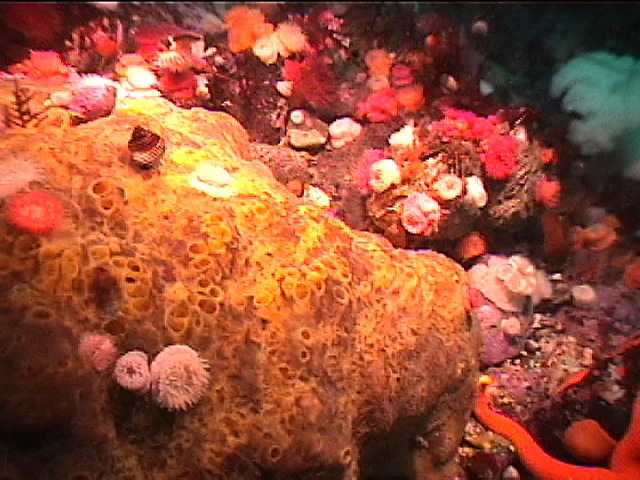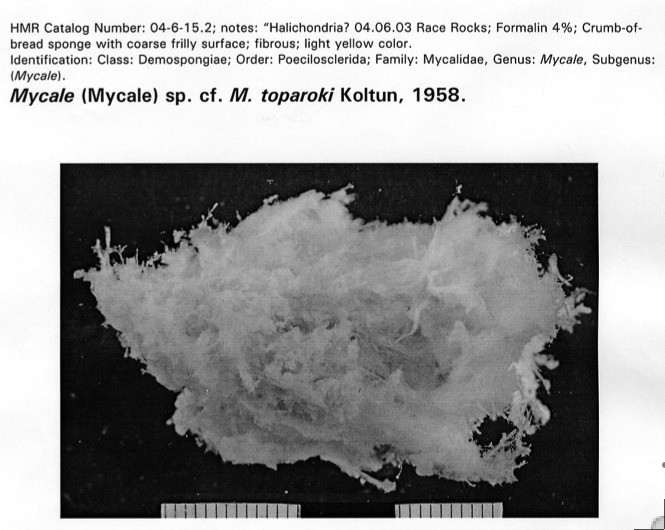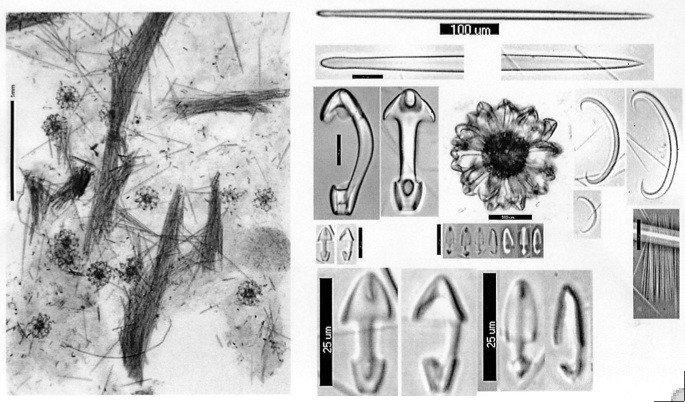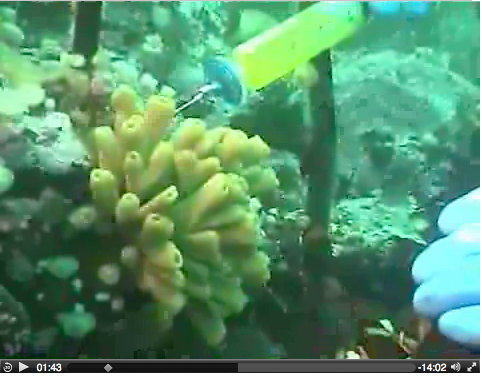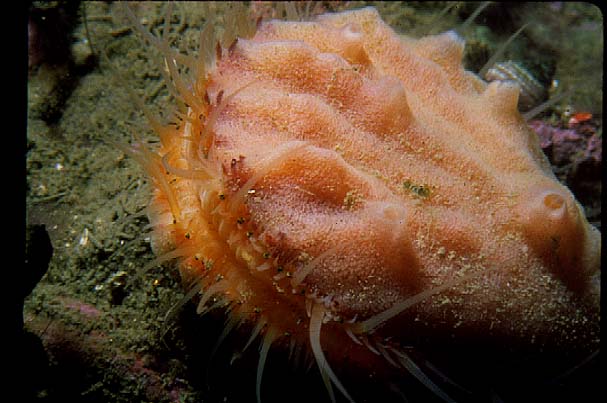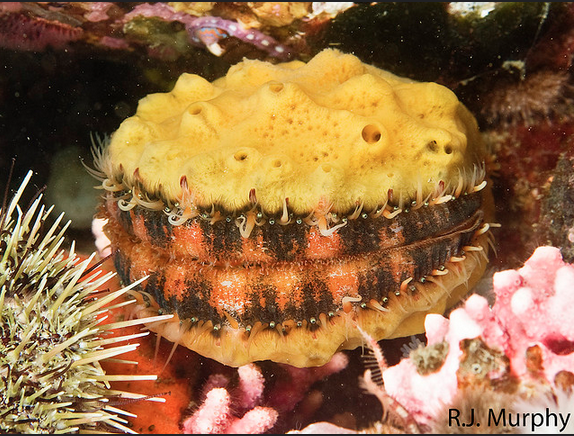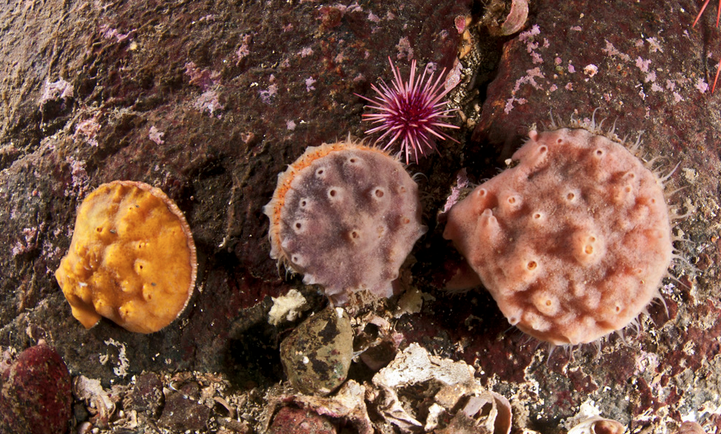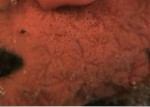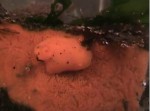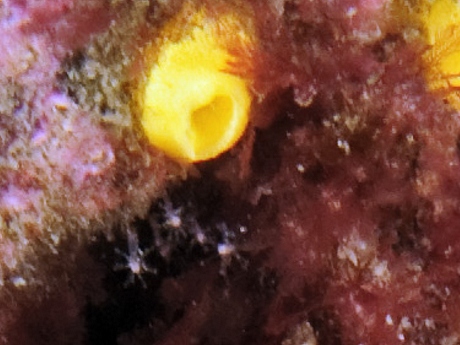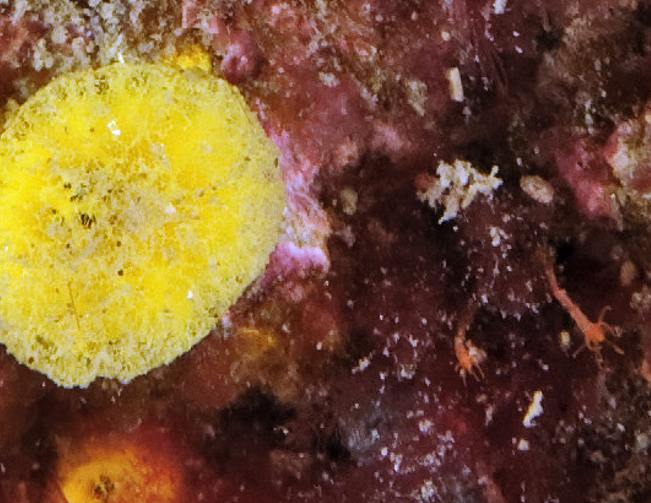Chris Blondeau and Juan Carlos Yabar, did this survey to document the Invertebrates, particularly hydroids,sponges and colonial tunicates in the are where the turbine Piling was to be installed later in the year.
Tag Archives: Sponge
Mycale toparoki: yellow sponge–The Race Rocks taxonomy
In the work of Dr. Gitai Yahel on filter feeders at Race Rocks, this was one of the species of sponge he submitted for further identification.
| Domain | Eukarya |
| Kingdom | Animalia |
| Phylum | Porifera |
| Class | Demospongia |
| Order | Poeciloscierida |
| Family | Mycalidae |
| Genus | Mycale |
| Species | toparoki Koltun, 1958 |
| Common Name: | yellow sponge? |
|
This file is provided as part of a collaborative effort by students, volunteers, faculty, staff and researchers of Lester Pearson College
|
Date: 2005 | Dr.Gitai Yahel |
Link to other sponge specimens from Race Rocks
Return to the Race Rocks Taxonomy
Isodictya rigida: finger sponge– Race Rocks Taxonomy
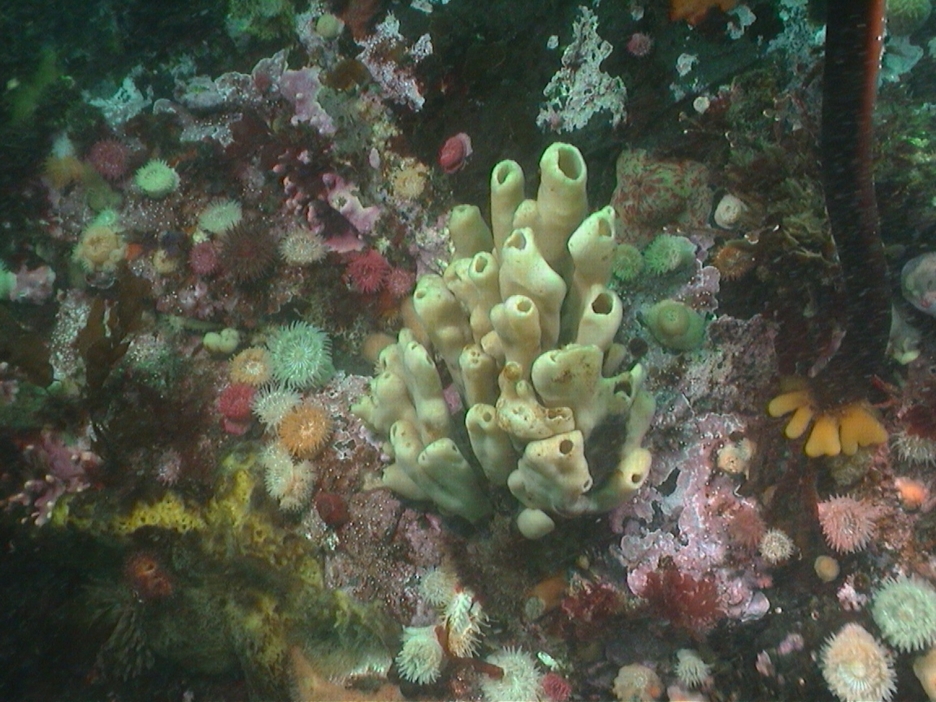
This image, taken by Russel Wyeth,assistant to Dr. Gitai Yahel off the docks at Race Rocks, shows the intricate associations of other invertebrates sharing the same habitat.
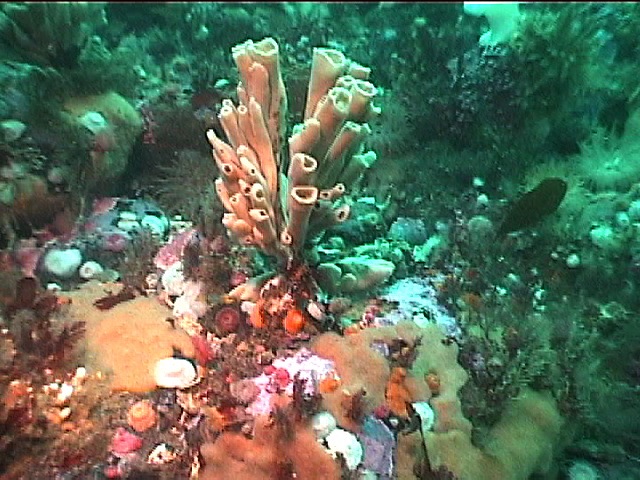
Juan Carlos took these images while doing a video of the path for the tidal generator cable.
The biodiversity in locations which receive heavy current is considerable. Depth 12 meters.
Kingdom: Animalia Phylum: Porifera Class: Demospongiae Order: Poecilosclerida Suborder: Mycalina Family: Isodictyidae Genus: Isodictya Bowerbank, 1864 Species: rigida ( Lambe, 1893)
|
This file is provided as part of a collaborative effort by the students, faculty,volunteers,staff and researchers of Lester B. Pearson College
|
Date: 2005 | Dr. Gitai Yahel |
In Situ Measurement of Benthic Community Trophic Dynamics at Race Rocks
Research of GITAI YAHEL
In March, 2004, Dr.Gitai Yahel, a Post Doctorate researcher from the Biology Department at the University of Victoria, joined us for two dives at Race Rocks to check out the possibility of doing research there. He is interested in suspension feeders’ nutritional ecology and the role of dissolved substance as a food source for marine organisms. Currently he is trying to establish a field survey of the dissolved and picoplanktonic diet composition of active suspension feeders such as sponge, mussels and tunicates.
Sponges, bivalves and tunicates play an important role in the trophic dynamics of many benthic communities. However, direct in situ measurements of their diet composition, filtration and excretion rates are lacking. Our knowledge of these rates is based mostly on indirect, in vitro measurements. Recently we have developed an in situ, non-intrusive technique to directly measure the rate and efficiency by which an active suspension feeder removes (or discharges) substances from (to) the water it filters. The technique, termed “InEx”, is based on the simultaneous, pair-wise collection of the water Inhaled and Exhaled by the animal. The difference in the concentrations of a substance among a pair of samples provides a measure of the retention (or excretion) of the substance by the animal. Calculations of feeding (or excretion) rates are obtained by multiplying the concentration difference by pumping rate. The latter is concurrently measured by recording the movement of a dye front in a transparent tube positioned within the ex-current jet. An important quality of the InEx technique is the lack of any manipulation of the studied organisms thus allowing realistic estimates of the organism’s performance under natural conditions. Former work in tropical water had revealed novel aspects of suspension feeders’ nutritional ecology including the major role dissolved organic substances play in the diet of some reef sponges (Yahel et al. 2003, Limnology and Oceanography, 48, 141).
For the proposed work at Race Rocks we can foresee two phases:
I. Identifying target suspension feeding taxa
We will execute a field survey of common suspension feeders at Race Rocks. Targets groups include bivalves, ascidians, and sponges. SCUBA divers will sample the water inhaled and exhaled by the surveyed organisms to compare concentration changes of CDOM, DOC, bacteria, phytoplankton, other organic particles, plant nutrients, silica, and sediment grains. Sampling methods will include an Inherent Optical Properties sensor (IOP, providing both CDOM spectra, concentration and optical characterization of the particulate field), Laser In Situ Scattering instrument (LISST, providing measurements of particles concentration and size distribution), and discrete water samples (InEx). The discrete water samples will be analyzed using a high temperature total carbon analyzer, flow injection nutrient analyzer, and a flow cytometer. This sampling scheme will provide ‘snapshot’ information on the performance of individual organisms.
II. Continuous monitoring of individual ‘model’ organisms.
Longer term (hours to days) monitoring of organisms will provide a record of feeding and metabolic performance with respect to environmental parameters (e.g., current, light, ambient particles concentration, etc.). Our knowledge of such processes in the field is limited. Nevertheless, the few existing studies suggest that suspension feeder activity may undergo considerable diel shifts. Moreover, environmental variables such as food and sediment concentration are known to affect suspension feeder filtration rates. Multi-day instrumentation of individual suspension feeders will provide a continuous record of the material fluxes mediated by the animals. Two 16 MHz ADVs’ (Acoustical Doppler Velocimeters) will provide high frequency (~2 Hz) current and acoustical backscatter data. One ADV will sample the exhalant jet of the study animal while the other will sample the inhalant (ambient) water. Similarly, paired measurements of optical water properties will be obtained by slowly pumping small amounts waters through a 4 sensor array mounted on a nearby frame. The instrument array will include: LISST-100, IOP sensors (WetLabs ac-9, and Eco-VSF,) CTD, and a Seabird oxygen sensor. The latter will allow us to estimate respiration rate and to correlate it to measured material fluxes mediated by the studied organisms. An online video camera equipped with an infra-red light source will be used to monitor the immediate vicinity of the exhalant aperture to allow better interpretation of behavior related signals (e.g. the presence of predators or sediment resuspension events).
Target organisms will be carefully selected based on the results of the survey in phase I. A priori, plausible candidates for these experiments are sponges and large bivalves (e.g. Mytilus californicus). These animals possess a large ex-current aperture that allows easy instrumentation and previous studies suggest that they may be capable of removing large quantities of DOC from the water.
Note that the proposed work in absolutely non destructive and the studied animals will not be manipulated by any means.
SEE ALSO https://www.racerocks.ca/journey-middle-school-students-visit-race-rocks/
~~~~~~~~~~~~~~~~~~~~~~~~~~~~~~~~~~~~~~~~~~~~~~~~~
Myxilla incrustans: incrusting sponge– The Race Rocks Taxonomy
This sponge can be found on rocky subtidal areas at Race ROcks It commonly grows over the surface of swimming scallop shells. It is believed to form a mutualistic association with the swimming scallop, obtaining a moveable substrate while preventing predation of the scallop. Apparently the smell of the sponge deters the sea stars which may be intending to prey on the scallop
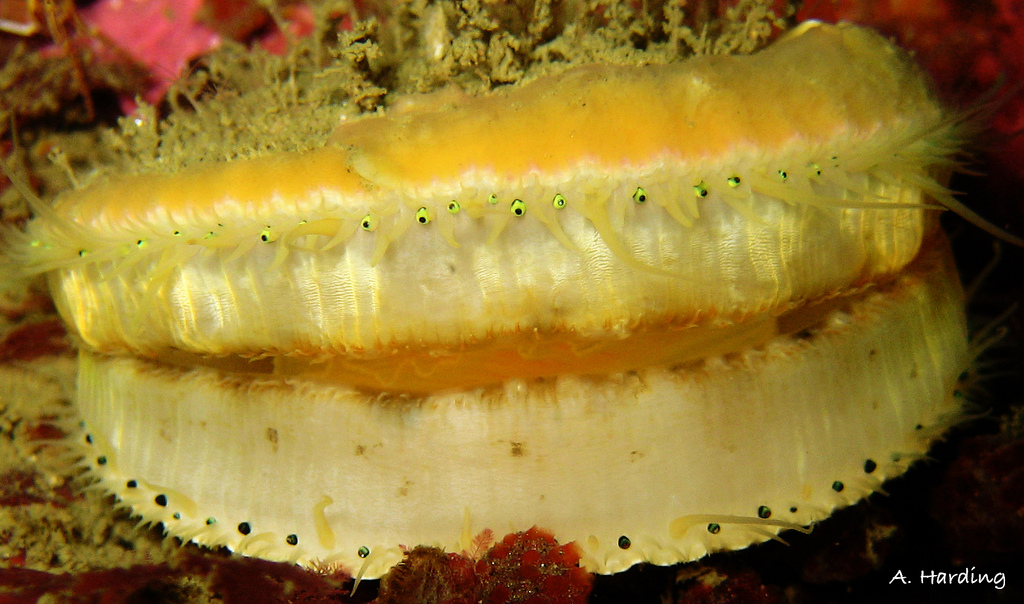
Adam harding took this photo off the docks at Race Rocks. The shell of the scallop is covered with the orangish layer of sponge with attached hydroids.
It is an extremely variable widely distributed species ranging from intertidal to 2540 m
Colour: the colour in life ranges through various shades of gold occasionally to a light gold-brown with a slight tinge of rose. In alcohol the sponge is grey-white to yellowish-brown.
Form: The sponge is incrusting or occasionally massive
Size: Intertidal incrusting forms re up to 8 cm thick an 20 cm in diameter. Dredged massive forms have a diameter of up to 9 cm. Fistules are up to 25 mm high.
Consistency: the consistency is moderately firm and tough. some specimens are weakly spongy and fragile.
Surface: The surface varies from slightly roughened and tuberculate to highly rugose and fistulated. It is somewhat rough to the touch
Oscules: oscules are common or abundant and irregularly distributed. Oscules may be elevated on fistules when the latter are present. Oscules are from 033 to 8 mm in diameter.
Pores: pores are abundant and measure from 20 to 270u in diameter.
| Domain | Eukarya |
| Kingdom | Animalia |
| Phylum | Porifera |
| Class | Demospongiae |
| Order | Poecilosclerida |
| Family | Myxillidae |
| Genus | Myxilla |
| Species | incrustans |
| Common Name: | incrusting sponge |
|
This file is provided as part of a collaborative effort by the students of Lester B. Pearson College
|
Oct 2003 | Roberto Ruglio year 30 |
Suberites suberea: Hermit Crab Sponge–The Race Rocks Taxonomy
Suberites suberea is also known as Suberites ficus .This sponge begins its life by attaching to a mollusc shell. As it grows, it overtakes the shell and eventually dissolves it. A hermit crab (Pagurus sp.) is usually found in the cavity of the sponge, but the sponge is usually quite larger than the crab itself. The sponge is hard and rubbery in texture, and is dark orange in colour. It is Found all around the intertidal and shallow subtidal areas of Race Rocks.
| Domain | Eukarya |
| Kingdom | Animalia |
| Phylum | Porifera |
| Class | Demospongiae |
| Order | Hadromeridia |
| Family | Suberitidae |
| Genus | Suberites |
| Species | suberea |
| Common Name: | Hermit Crab Sponge |
This file is provided as part of a collaborative effort by the students of Lester B. Pearson College Dec. 2002 Jana Morehouse Link to other sponge specimens from Race Rocks Link to the Race Rocks Taxonomy and Image gallery index
| This file is provided as part of a collaborative effort by the students, faculty, staff and volunteers of Lester B. Pearson College | Dec. 2002 | Jana Morehouse |
Ophlitaspongia pennata: velvety red sponge–The Race Rocks taxonomy
The red sponge, Ophlitaspongia pennata and the nudibranch Rostanga sp. were found at a low tide in the late evening in November near the end of the docks, just beside the slipway at Race Rocks. These images are from the video below.
- Note grooves in the surface of the sponge which are grazing paths.
- The nudibranch Rostanga grazing on the red sponge.
There are likely to be several types of encrusting red sponges growing in narrow crevices and on the undersides of overhanging ledges. Indeed, there are about ten intertidal species of red to orange encrusting sponges along the Pacific coast. Ophlitaspongia pennata is a beautifully coral-red form characterized, especially after drying, by starry oscula; its surface is velvety. De Laubenfels (1932) remarked that it occurs clear up to the half-tide mark (higher up than any other sponge), especially on vertical rocks under pendant seaweed, hence shaded from direct sunlight. Ophlitaspongia pennata is recorded from (Vancouver Island), British Columbia, to near Puertocitos, Baja California.
| Domain | Eukarya |
| Kingdom | Animalia |
| Phylum | Porifera |
| Class | Demospongiae |
| Order | Poecilosclerida |
| Family | Clathriidae |
| Subclass | Ceractinomorpha |
| Genus | Ophlitaspongia |
| Species | pennata |
| Common Name | Velvety Red Sponge/ Red Midtide Sponge |
This type of Red Sponge can be colored bright red to almost a dull orange-red. It has a smooth and tough surface. It has holes scattered around on it: the holes are about 2 millimeters wide. Its predators are nudibranchs, snails and seastars. They feed on shrimp, crabs and many other organisms.These tiny flat red to orange colored sponges encrust vertically on rocks shaded from sunlight.Biotic Associations: Often found with a predator, Rostanga pulchra
| This file is provided as part of a collaborative effort by the students, faculty, staff and volunteers of Lester B. Pearson College | February 2002 | Sarah MonsalveR. Colombia PC Yr 28 |
Cliona celata: Boring Sponge–Race Rocks taxonomy
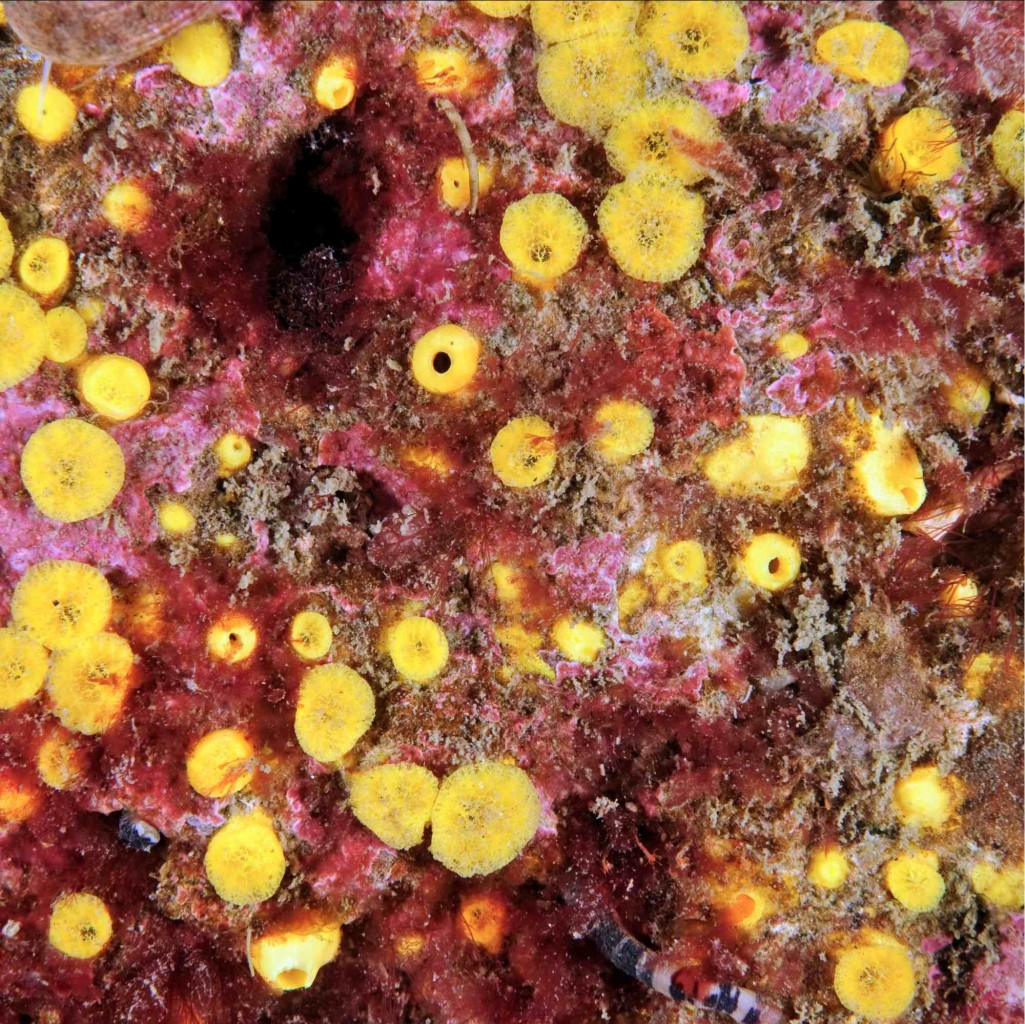
Cliona celata: This closeup image was taken by Ryan Murphy in May 2010. Clicking on the image gives a very large magnification. Clicking on the image below gives a sample of that level of magnification.
- small white unidentified hydroids
- These images show hydroids which are living in association with Cliona and the scallop.
Domain Eukarya
Kingdom Animalia
Phylum Porifera
Class Demospongiae
Order Hadromerida
Family Dysideidae, Tetilla
Genus Cliona
Species celata
Common Name: Boring sponge
Cliona celata is lobular in shape with wart like projections on it surface. This species is commonly found in colonies and the portions of the colony showing at the surface have projections appearing as yellow in color. They are evenly distributed on the sponge and are inhalent and seive like. Below the surface, the Cliona celata shell may look like a honeycomb. Cliona celata is commonly referred to as the boring sponge because it bores into soft limestone, using an acid digestion technique thus forming systems of interconnecting chambers within the matrix of the substrate
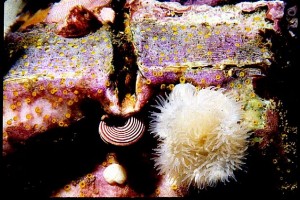
The opened up hinge area of the Purple Hinged Rock Scallop. Calliostoma is the snail and Metridium is the anemone. G.Fletcher photo.
The sponge can also bore as a parasite into mollusc and barnacle shells. It is common on many of the purple hinged rock scallops that we see underwater at Race Rocks.
At Race Rocks, the boring sponge is commonly found around the Rosedale Reef area. Its exhibits a biotic association with the purple -hinge rock scallop (Hinnites giganteus ) . Below is a picture of a complete rock scallop with small yellow dots where the sponge is located.
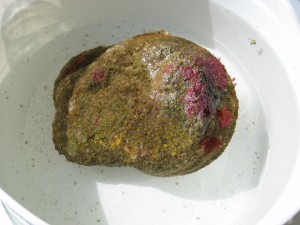
Boring sponges are the small yellow dots on the outside of this live Rock Scallop which measures 18 cm in diameter.
References: As of 2001
http://web.ucs.ubc.ca/csmecher/demospon.htm
http://www.diveinfo.com/porifera
http://www.itsligo.ie/biomar/porifera/clicel.htm
Kozloff, Eugene.N, Keys to the Marine Invertebrates of Puget Sound, the San Juan Archipelago, and Adjacent Regions; University of Washington press, 1974.
Other Members of the Phylum Porifera at Race Rocks.
and Image File |
 The Race Rocks taxonomy is a collaborative venture originally started with the Biology and Environmental Systems students of Lester Pearson College UWC. It now also has contributions added by Faculty, Staff, Volunteers and Observers on the remote control webcams. Dec. 2001–Misozi Phiri PC year 27 The Race Rocks taxonomy is a collaborative venture originally started with the Biology and Environmental Systems students of Lester Pearson College UWC. It now also has contributions added by Faculty, Staff, Volunteers and Observers on the remote control webcams. Dec. 2001–Misozi Phiri PC year 27 |
;
